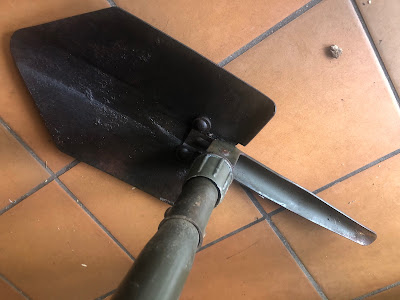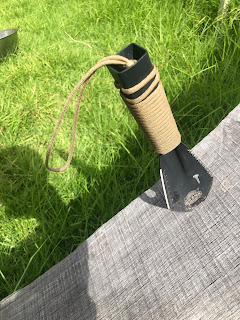The entrenching tool appears to be a Bushtracks folding entrenching tool with Pick' which had seen better days. The screw-down locking bracket had partially seized but with a little elbow grease and liberal WD-40, I got it worked loose enough to unfold the shovel-head and the pick head, with a little extra work I cleared the screw threads of grit and get it working smoothly.
The next step was to wash and scrub the rusted shovel face and pick. Luckily the hinge and locking bracket were not especially rusted. Once the loose crud and dust was removed, I heated the shovel head over the gas range hood to drive off any remaining moisture and coated it liberally with linseed oil as a seasoning mechanism. I did this outside as the hot steel vaporized the oil into old-timey smelling white clouds.The scrubbing and seasoning paid off and the surface has remained rust-free despite quite a lot of digging, both in the garden and trips to the beach where I use it to fill ballast sand-bags for our sun shelter. I have previously reported on my black tri-fold e-tool and the much smaller tactical-dump trowel but i'll be comparing the two e-tools, as they're in the weight-class.
I'll start by breaking the tool down into its major elements: the shovel, the pick and the haft.
 The working end of the shovel is a triangular tipped square side shovel, with a gentle scoop. The tip is rounded and the edges are quite wide for durability, unlike the tri-fold which has a decidedly sharpened edge. One of the square sides has a sawtooth edge cut into it. The shovel face is riveted onto the hinge piece with three hefty rivets. The shovel has three positions, folded flat, 90 degree "Pick mode" and full extension. when folded flat the "head" of the shovel between the rivets makes a half decent hammer face, perfectly suitable for driving tent stakes in, not so much for fine carpentry.
The working end of the shovel is a triangular tipped square side shovel, with a gentle scoop. The tip is rounded and the edges are quite wide for durability, unlike the tri-fold which has a decidedly sharpened edge. One of the square sides has a sawtooth edge cut into it. The shovel face is riveted onto the hinge piece with three hefty rivets. The shovel has three positions, folded flat, 90 degree "Pick mode" and full extension. when folded flat the "head" of the shovel between the rivets makes a half decent hammer face, perfectly suitable for driving tent stakes in, not so much for fine carpentry.
 The screw-down locking bracket features a big washer to aid in keeping a tight fit when tightened which has stood up to some enthusiastic hammering and digging.
The screw-down locking bracket features a big washer to aid in keeping a tight fit when tightened which has stood up to some enthusiastic hammering and digging.
When folded out in "Shovel mode" the tool stretches to a fairly decent 62 cm (24 2/5") length, slightly longer than the delta-handled tri-fold. Length is leverage and leverage is force, both have utility when digging, and the extra length has little impact on its pack-ability at 42cm (16 1/2") fully folded.
At 860g (lbs 14oz) its a reasonable tool to carry around, especially if you know you'll need to dig more than a trowels amount (be it a fire-pit, latrine pit-trap or fighting position.) The wide edge does not lend itself to axe-like chopping in the way the tri-folds per-sharpened edges do ,though they could take an edge without too much effort (either hand file or powered grinding tool). The saw teeth could be sharpened up without degrading the robustness of the tool, but that's a project for another day. I have been primarily using this in the vegetable garden, tilling soil, digging up potatoes and shifting delivered soil into our raised beds.
 The Pick tool folds and locks in place the same way as the shovel does. The most useful position being at 90 degrees to the haft. The spike itself is curved along the whole length of the pick for strength and extends out 21 cm (8 1/4") from the haft.
The Pick tool folds and locks in place the same way as the shovel does. The most useful position being at 90 degrees to the haft. The spike itself is curved along the whole length of the pick for strength and extends out 21 cm (8 1/4") from the haft.
It is possible to operate the tool with both shovel and pick extended, but its a bit cumbersome. Easier to use one tool and swap between the two. The pick isn't sharp-tipped, featuring the same robust edge as the shovel, but its not expected to be a mining tool.
The pick, when folded flat against the haft, can also serve as a hammer, though the rounded back face of the pick makes for a tricky strike surface, but possible.
The pick can also be folded "upwards" into a "spear" configuration, extending the tool into a length of 58cm. Good for getting to the bottom of a hole, reaching the top shelf or possibly ventilating an unwanted visitor to your trench.
The original haft was held in place by a rivet through the throat of the locking bracket, and whilst giving the tool a good bash test, trench-club style, I managed to snap it off at the bracket. After sitting unloved in a pile of scraps for half a year, including a house move, I dug it out, ground down the rivet head with an angle grinder, whittled a new head to the shaft, fitted it after a little char-hardening and set it with a clinch-nail. This cost me 2-3 inches of over-all length, but with my longer than average wingspan, it's none the worse.
Though it doesn't fold down as small as the tri-fold, nor stow away in its own belt pouch (though military surplus canvas pouches exist), this is a solid tool rich with utility and with years more life in it, both in the garden and on the trail.
At some stage I may throw a sharp edge on the shovel for root/brush chopping and i'm certainly going to try my hand at sharpening the saw edge, but all in all I'm very happy with this restoration and salvage of a "lost" tool.
For the God-Emperor! For Krieg!


















































